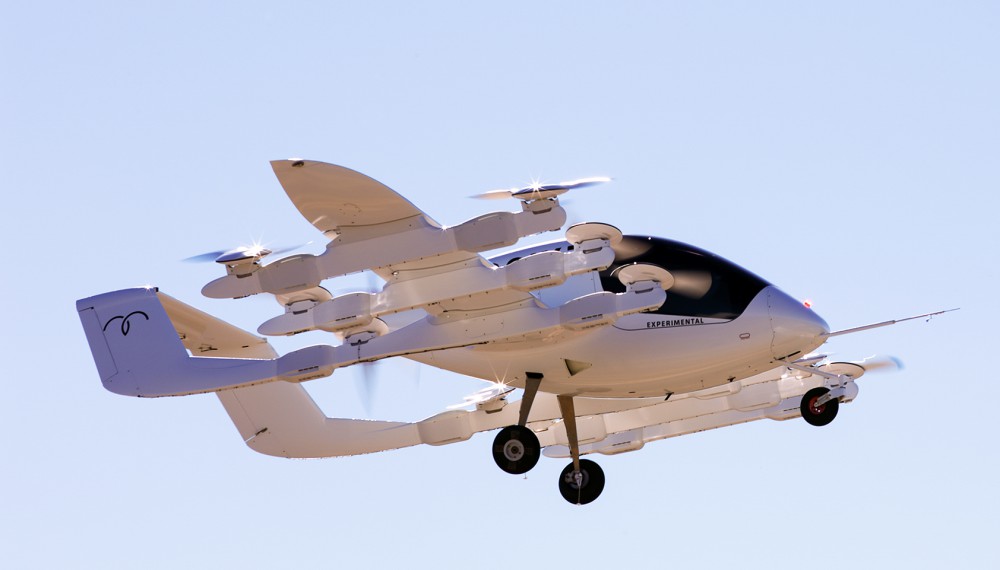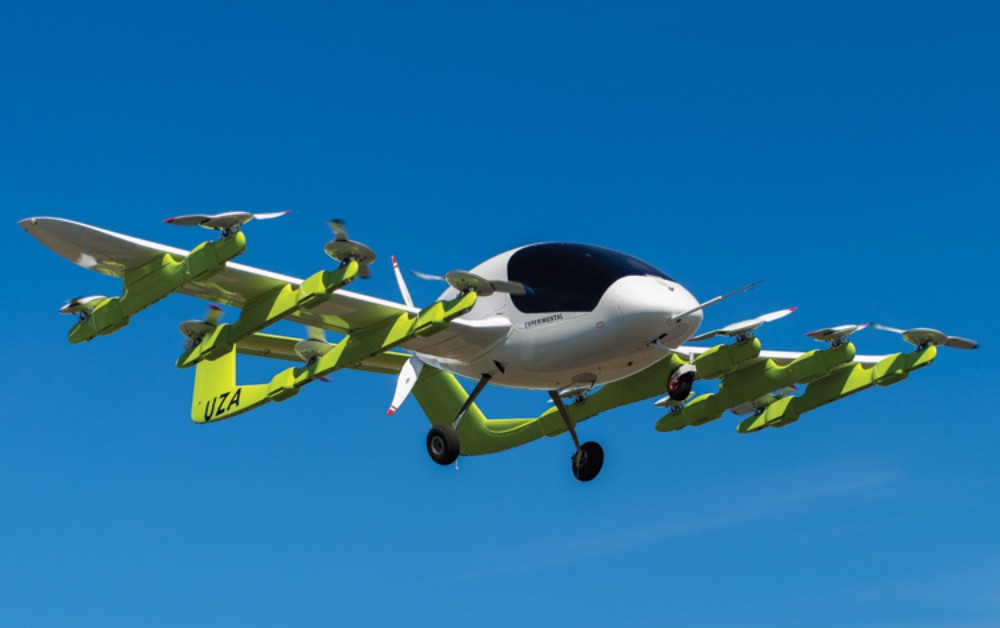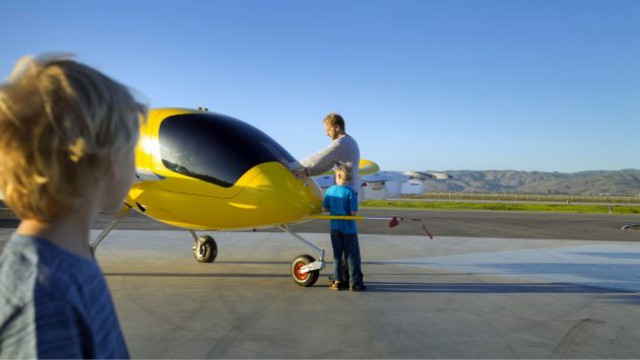Kitty Hawk, the secretive flying-car startup funded by Alphabet CEO Larry Page, has finally taken the wraps off its flying taxi, which it calls Cora. In a quiet corner of Canterbury, a new type of autonomous, electric “flying car” has been secretly tested since October. Its creators hope a flying taxi service could take to the skies in New Zealand within six years.
The project is backed by some of the brightest minds in the aviation and transport technology industries, including former staff from the likes of Google, NASA, Boeing and Honeywell. Among them is the so-called godfather of the self-driving car.
Their intention is for people to eventually use the flying vehicle, called Cora, for short trips they typically take by car, to combat the growing problem of vehicle congestion on the ground.
The vehicle, which has been in development for eight years, can take off and land vertically, much like a helicopter. It is electric-powered and will be flown by self-piloting software – with human oversight from the ground. It has a range of about 100 kilometres and can hit speeds of 150kmh. The prototype can carry two passengers.
The New Zealand trial is seen as an opportunity for the country and Canterbury to establish itself as a hotbed for the research and development of cutting-edge technology, which the Government sees as a key area for growth.
Prime Minister Jacinda Ardern said the programme was about “sending the message to the world that our doors are open for people with great ideas who want to turn them into reality”. Christchurch Mayor Lianne Dalziel said the project was “a great example of our commitment to be prepared for the future”.
Cora is being developed by California-based Kitty Hawk Corporation, which is reportedly funded by Google co-founder Larry Page. The New Zealand operator is called Zephyr Airworks.
Kitty Hawk chief executive Sebastian Thrun is a computer scientist who founded Google’s research and development facility X, where he led Google’s self-driving car project. Zephyr Airworks boss Fred Reid has been chief executive of Virgin America and president of both Lufthansa and Delta Air Lines during his career in aviation spanning over 30 years.
Both are convinced this new type of vehicle is the future of transport. Reid said the concept would be commonplace “10 or 20 years from now”. Thrun said road traffic was incredibly congested and there was no space to dramatically increase road capacity. The air is incredibly big and incredibly empty.
The company carried out a global search before settling on New Zealand for the trial. Reid said some of the important things they looked for was the ability to gain native certification (certification from design right through to commercialisation), which is only available in a handful of countries, good intellectual property protection laws, and a place that was open to new ideas.
Talks between Kitty Hawk and the Government have been ongoing for about 18 months, with multiple Government agencies coming together to streamline the set up for the trial.
Thrun said when meeting people from the Government for the first time, the first question everyone asked was how they could make the process faster for Kitty Hawk. He said he considered New Zealand “a bit of a Galapagos” in that things could happen very quickly, and the hospitality and openness seen from the Government is “unparalleled”.
There are significant issues to be worked through before the public will be able to hop into an air taxi. This type of vehicle has never been certified for commercial use anywhere in the world, so there is no precedent to guide the process. The same problem exists for working out how such an air taxi service would be regulated.
Civil Aviation Authority deputy director of general aviation Steve Moore said the authority was working to “define a bespoke set of certification requirements” to be applied to Zephyr Airway’s first commercial operation – an approach believed to be “unique within the global aviation environment”.
A Civil Aviation Rule which came into affect in 2015 provided a legal framework as to how unmanned vehicles can be operated. Moore said the rule provided a “sound basis” for operating unmanned aerial vehicles but there were “significant” regulatory challenges still being worked through around how a service would share airspace with other aircraft and how the rules would work when the vehicle was out of sight of those overseeing it from the ground.
Those developing Cora are realistic about the significant challenges they face in bringing an air taxi service to the public, but still believe the technology will be operating in a limited capacity in New Zealand in the next ten years.
Reid said there was “a really good shot of doing this in the relatively short future”, and was striving to have limited services operating in New Zealand in the next three to six years.
He sees the vehicles initially operating as a fleet managed by Zephyr Airworks, running on set routes under close supervision. The supply of the aircraft would be limited at the start, and the price of the service would reflect that, but the “absolute goal” was to make it as accessible for everyone; “this isn’t designed for billionaires”.
What does the trial mean for New Zealand?
The flow on effects for New Zealand could be significant. Reid said New Zealand had the opportunity to become a “global centre for excellence” in the emerging industry. He estimates Zephyr Airworks alone has already added millions of dollars to New Zealand’s economy, but things were only at the start.
Benefits would come in the form of employment, increases in training and technical knowledge, and opportunities in manufacturing and possibly assembly of the aircraft. Kitty hawk’s website, which launched Tuesday, already has several job listings for aircraft technicians and flight test engineers.
All parties see the trial as a partnership, and believe they have commitments and obligations to each other.
Hosting the trial fits in with the Government’s broader strategy. Research, Science and Innovation Minister Megan Woods on Tuesday launched an Innovative Partnership’s programme aiming to attract international companies working in future-focussed technologies to develop their products in New Zealand.
Woods said the growing research and development activity was “a key lever to diversify the economy” by creating new industries, businesses and jobs, and would help keep local talent local.
Ministry of Business, Innovation and Employment general manager for science, innovation and international Dr Peter Crabtree said the ministry was focussed on turning New Zealand’s small size and distance into an advantage, and there was an interest in raising New Zealand’s level of investment in research and development.
He said being able to work right across the whole of Government to line up aspects such as regulatory systems, infrastructure, skills and education had resonated with a lot of international businesses they had been in talks with.
Crabtree said a lot of possible projects were quickly filtered out. To be part of the programme an idea needed to be knowledge intensive, cutting edge, and have a clear pathway to adding value to New Zealand.
The trial fits with Canterbury authorities’ goal for the region to focus on future technologies and test new ways of doing things. The city is already hosting a trial of an autonomous shuttle at the airport, and is the first city in New Zealand to have an electric car-sharing fleet available to the public.
Dalziel said Christchurch was embracing opportunities in future transport, future foods, Antarctica and space technology, and technical adventure clothing. She said the city was “open for business and making strong strides in these areas”.
ChristchurchNZ chief executive Joanna Norris said the trial put Christchurch on the map as a place that partners with international organisations to help them realise their ambitions, but those organisations had an obligation to return something to the community.
She said it was difficult to assess the economic benefit, but building expertise around future transport, future flight and autonomous vehicles would attract similar businesses and activity to the region.
“We’ve got the right conditions, in that we’ve got great regulations, great connectivity internationally, wide open space and a local authority that is committed to trialling new technologies.”
Source: stuff



